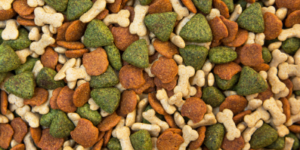Part One: Dog Food Pros And Cons – Commercial Dog Food Options
Today, there are more types of commercial dog food on the market than ever before. Each particular type of dog food has pros and cons, and it is up to the dog owner to choose the best option for their puppy or dog. There is no one type of dog food that is the ideal option for all dogs, all ages of dogs, and all dog types, but there are foods that are better than others based on the health, age, and activity level of your canine companion.
While there are always brands that claim to offer specific benefits over others, it is also essential to consider the pros and cons of the different types of food. As this is becoming a much larger conversation, it is easier to break it down to traditional commercial dog food options and then a separate discussion on new “whole food” types of dog food and raw or homemade diets.
There are three types of commercially available dog food products on the market. These include dry kibble, canned food, and dog food in pouches (also known as semi-moist food). Let’s take a closer look at the benefits and the considerations with each of these options.
Dry Kibble
Quality dry kibble has a guarantee of nutritional content, and it meets all the requirements for a dog when fed according to the manufacturer’s recommendations based on weight. This is an easy-to-store and feed formula, and it is also typically more cost-effective than other options.

The potential drawbacks to kibble formulations are the fillers and by-products used in the formulation of the cheap types of dog foods. For dogs prone to weight gain, those with food allergies, or dogs that react to the carbohydrates (grains) in the formula, these types of foods can be problematic. Some dogs will resist eating dry kibble if they have been fed other dog food formulations.
Canned Foods
Most dogs love the flavor of canned dog foods. There are few preservatives if any, and canned foods tend to use meat rather than meat by-products. Wet/canned food is generally lower in carbohydrates and comes with a nutritional guarantee.
The cons to canned food are the price, particularly for those with larger dogs. Low-quality wet food may be high in meant by-products and offer limited actual meat, vegetables, and healthy grains. Wet food may contain high levels of fat, which can be problematic and create digestive problems for some dogs and puppies. Watch for words flavor, with, dinner, entrée, or platter as these indicate only a small percentage of the ingredients in the food are actually those listed on the label. In fact, the word flavor just means the taste has to be detected.
Pouches
Dog food pouches, also known as semi-moist foods, are most commonly fed by small to medium dog owners. These are convenient to feed, easy to take for your pet if you travel, and offer portion-controlled sizes for convenience.
Semi-moist food has about 60% water and higher levels of salt and sugar than either canned or dry kibble. If choosing pouches, be sure to check the ingredient list and the nutritional guarantee.
Always check the ingredients listed. They must be listed by their presence in the food based on weight or liquid measure. Choose the best quality of food possible, which may not be the brand name most often advertised on television.
Stay tuned for Part Two of this article where we explore other types of dog food such as natural varieties, which we will be carrying at our DogiMarket opening soon.

